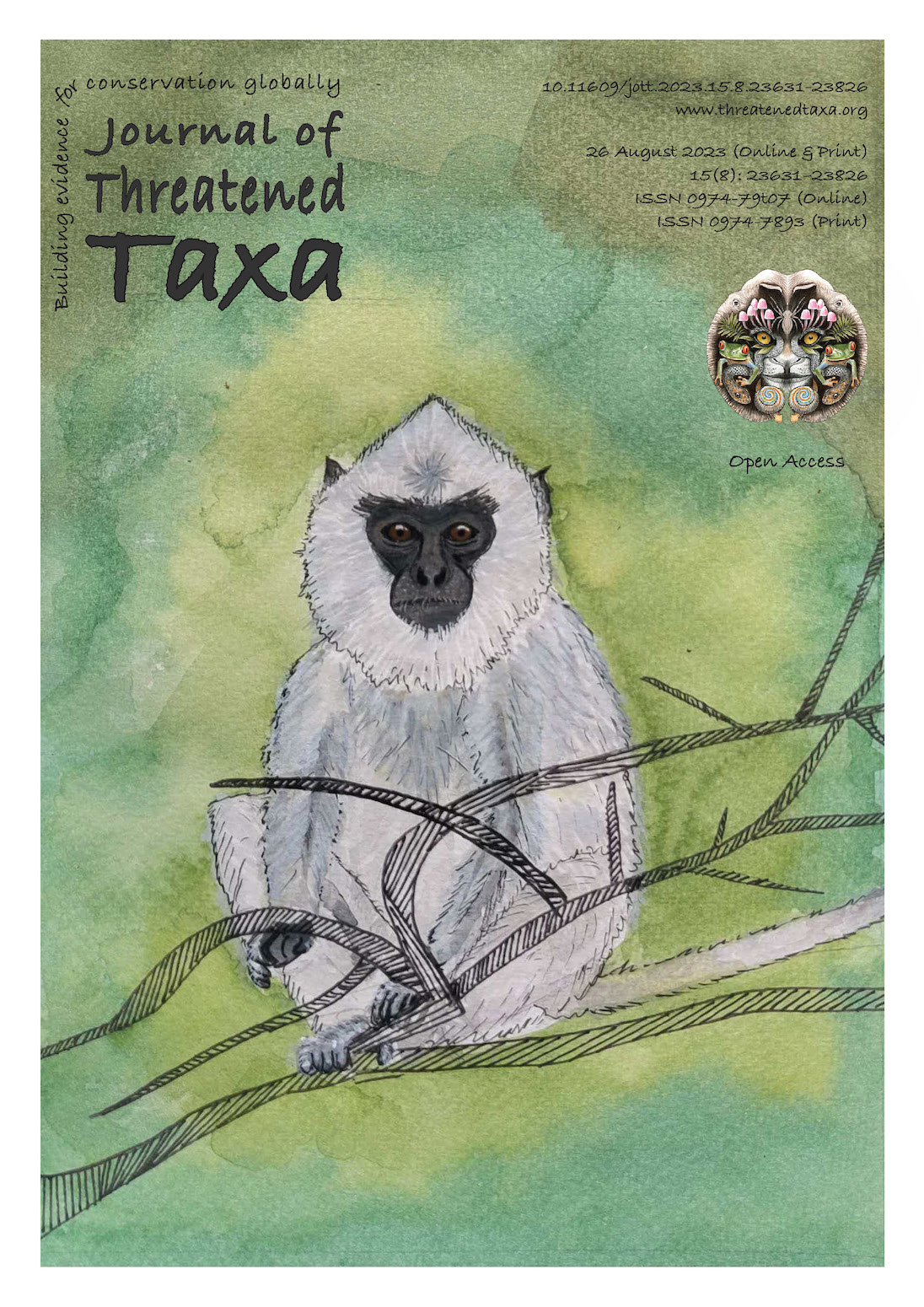Avifaunal diversity of Tsirang District with a new country record for Bhutan
Main Article Content
Abstract
Birds play a vital role in ecosystems. Studying avifaunal diversity therefore has a noteworthy role in indicating nature’s ecological balance in the environment. A total of 749 bird species have so far been recorded in Bhutan. We present a comprehensive checklist of birds of Tsirang, District which largely lies outside Bhutan’s protected area system. The data was collected through opportunistic encounters and with regular field visits to a range of locations in different seasons. One-fourth of the country’s total avifauna and a new species recorded for Bhutan, The Plum-headed Parakeet Psittacula cyanocephala was recorded as part of this study. In all, 285 avian species belonging to 18 orders and 65 families including one globally ‘Critically Endangered’, three ‘Vulnerable’, and a ‘Near Threatened’ species were recorded during the survey. The high species richness of birds in the study area reveals that it includes good habitats for birds in Bhutan. Similar studies are suggested in other areas contiguous to the protected areas in Bhutan including the current study area. This should aid in understanding of the factors driving the differences in bird diversity within and outside the protected areas so as to facilitate informed conservation actions in future.
Article Details

This work is licensed under a Creative Commons Attribution 4.0 International License.
Authors own the copyright to the articles published in JoTT. This is indicated explicitly in each publication. The authors grant permission to the publisher Wildlife Information Liaison Development (WILD) Society to publish the article in the Journal of Threatened Taxa. The authors recognize WILD as the original publisher, and to sell hard copies of the Journal and article to any buyer. JoTT is registered under the Creative Commons Attribution 4.0 International License (CC BY), which allows authors to retain copyright ownership. Under this license the authors allow anyone to download, cite, use the data, modify, reprint, copy and distribute provided the authors and source of publication are credited through appropriate citations (e.g., Son et al. (2016). Bats (Mammalia: Chiroptera) of the southeastern Truong Son Mountains, Quang Ngai Province, Vietnam. Journal of Threatened Taxa 8(7): 8953–8969. https://doi.org/10.11609/jott.2785.8.7.8953-8969). Users of the data do not require specific permission from the authors or the publisher.
References
Ali, S. (1941). The Book of Indian Birds. The Bombay Natural History Society, Bombay, 300 pp.
Bhutan Birdlife Society (2021). https://www.facebook.com/bhutanbirdlifesociety /photos/a.622056094540699/3997779533634988/. Downloaded on 27 April 2021
Bilgrami, K.S. (1995). Concept and Conservation of Biodiversity. CBS Publishers and distributors, Delhi, India.
BirdLife International (2017). Aceros nipalensis (amended version of 2016 assessment). The IUCN Red List of Threatened. Species 2017: e.T22682510A110040952. Downloaded on 18 May 2018. https://doi.org/10.2305/IUCN.UK.2017-1.RLTS.T22682510A110040952.en
BirdLife International (2017). Ardea insignis (amended version of 2017 assessment). The IUCN Red List of Threatened Species. 2017: e.T22697021A118359844. Downloaded on 18 May 2018. https://doi.org/10.2305/IUCN.UK.2017-3.RLTS.T22697021A118359844.en
BirdLife International (2016). Sitta formosa. The IUCN Red List of Threatened Species 2016: e.T22711231A94285206. Downloaded on 18 May 2018. https://doi.org/10.2305/IUCN.UK.2016-3.RLTS.T22711231A94285206.en
Bishop, K.D. (1999). Preliminary notes on some birds in Bhutan. Forktail 15: 87–91.
Clements, F.A. (1992). Recent records from Bhutan. Forktail 7: 57–73.
Dendup, P., S. Dorji, R. Dorji, L. Wangdi, T. Wangchuk, P. Dorji & P. Kuenzang (2020). Birds of Jigme Dorji National Park: A Photographic field guide for the park visitors. Department of Forest and Park Services of Bhutan, 233 pp.
FRMD (2017). Land use and land cover of Bhutan 2016: Maps and statistics. Forest Resource Management Division. Department of Forest and Park Services, Thimphu, Bhutan.
Grimmett, R., C. Inskipp & T. Inskipp (1999). Birds of the Indian Subcontinent. Cristopher Helm Publishers, London, UK, 288 pp.
Grimmett, R., C. Inskipp, T. Inskipp & Sherub (2019). Birds of Bhutan and the Eastern Himalayas. Bloomsbury Publishing. London, UK, 416 pp.
Gyeltshen, P., C. Norbu & K. Rinchen (2020). Avifauna found in the State Reserved Forest Land of Trongsa district, Bhutan. Bhutan Journal of Natural Resources & Development 7(1): 55–72. https://doi.org/10.17102/cnr.2020.46
Harisha M.N. & B.B. Hosetti (2009). Diversity and distribution of Avifauna of Lakkavalli range forest, Bhadra Wildlife Sanctuary, Western Ghats, India. Ecoprint 16: 21–27.
Inskipp, C. & T. Inskipp (1993). Birds recorded during a visit to Bhutan in autumn 1991. Forktail 8: 97–112.
Inskipp, C., T. Inskipp & R. Grimmett (1999). Birds of Bhutan, London and Thimphu. Christopher Helm and WWF.
Ludlow, F. & N.B. Kinnear (1937). The birds of Bhutan and adjacent territories of Sikkim and Tibet. Ibis 79(1): 1–46. https://doi.org/10.1111/j.1474-919X.1937.tb02161.x
Mohammad, J. & P.V. Krishna P.V. (2016). Avifaunal Diversity of Wyra and Paler Reservoirs of Khammam District, Telangana, India. Species 17(57): 160–174.
Manakadan, R. & A. Pittie (2001). Standardized English and scientific names of the birds of the Indian subcontinent. Buceros 6(1): 1–38.
National Biodiversity Centre (2019). Biodiversity statistics of Bhutan, 2017: A preliminary Baseline. National Biodiversity Centre (NBC), Thimphu, Bhutan, 65 pp.
Shah, T.A., V. Ahuja, M. Anandam & C. Srinivasulu (2016). Avifauna of Chamba District, Himachal Pradesh, India with Emphasis on Kalatop-Khajjiar Wildlife Sanctuary and its surrounding. Journal of Threatened Taxa 8(1): 8333–8357. https://doi.org/10.11609/jott.1774.8.1.8333-8357
Stattersfield, A.J., M.J. Crosby, A.J. Long & D.C. Wege (1998). Endemic bird areas of the world: priorities for biodiversity conservation. BirdLife International, Cambridge, UK, 846 pp.
Tsirang (2021). http://www.tsirang.gov.bt/index.php/. Downloaded on 10 March 2021.

